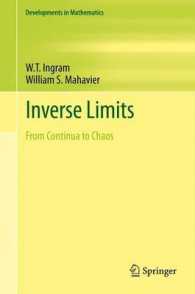- ホーム
- > 洋書
- > 英文書
- > History / World
Full Description
Winner of the 2019 Dr. Sona Aronian Book Prize for Excellence in Armenian Studies (NAASR)
From the tenth to the thirteenth centuries, the city of Ani was the jewel of the Armenian kingdom, renowned far and wide for its magnificent buildings. Known as the city of 1001 churches, Ani was a center for artistic innovation, and its architecture is a potential missing link between Byzantine and Gothic styles. By the fifteenth century, Ani was virtually abandoned, its stunning buildings left to crumble. Yet its ruins have remained a symbol of cultural accomplishment that looms large in the Armenian imagination.
The Ruins of Ani is a unique combination of history, art criticism, and travel memoir that takes readers on a thousand-year journey in search of past splendors. Today, Ani is a popular tourist site in Turkey, but the city has been falsified in its presentation by the Turkish government in order to erase Armenian history in the wake of the Armenian Genocide. This timely publication also raises questions about the preservation of major historic monuments in the face of post atrocity campaigns of cultural erasure.
Originally written by young priest Krikor Balakian in 1910, just a few years before the Armenian genocide, this book offers a powerful and poignant counterpart to Balakian's acclaimed genocide memoir Armenian Golgotha. This new translation by the author's great-nephew, Pulitzer Prize-winning poet Peter Balakian, eloquently renders the book's vivid descriptions and lyrical prose into English. Including a new introduction that explores Ani's continued relevance in the twenty-first century, The Ruins of Ani will give readers a new appreciation for this lost city's status as a pinnacle of both Armenian civilization and human achievement.
Contents
Contents
Introduction by Peter Balakian
Chapter I: The History of Ani
Part I-The Foundation and Flourishing of Ani
Part II-The Sale of Ani
Part III-The Seljuk Invasions and the Destruction of Ani
Chapter II: The Topography of Ani
Chapter III: The Description of the Ruins of Ani
The External Walls
The Cathedral
Surp Krikor Lusaworich' [St. Gregory the Illuminator] Church
Surp Aṙak'elots' [Holy Apostles] Church
Abughamrents' Surp Krikor Church
Kakgashēn [Gagkashēn] Surp Krikor Church
Vrats' [Georgian] Church
The Palace of the Pakradunis
Ani's Residence of the Catholicos
The Statue of Kakig [Gagik] I
Ani's Citadel
The Girls' Fortress
The Two Story Bridge and the Pekhents' Monastery
The Tombstone of the Royal Princes
The Ruins of the Royal Bath
The Royal Road Leading to the Akhurian River
Ghōshavank' Near Ani [The Monastery of Hoṙomos]
The Vaulted and Pillared Inner Part of the Royal Conference Hall in Ghōshavank'
Surp Minas and Surp Kevork Chapels in the Valley of Ghōshavank'
The Tomb of King Ashod [Ashot] the Merciful
Chapter IV: Scholarly Ani
Part I-The Armenian Architectural Style
Ani's Plan [illustration]
Part II-The Present Excavations of Ani
Voyage to Ani
His Holiness the Holy Patriarch's Voyage to Ani
The Pilgrim of Ani
Acknowledgments
Glossary
Index







